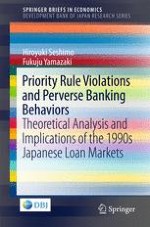2017 | Supplement | Chapter
4. Economic Analysis of Excess Additional Credit (Loan Evergreening)
Authors : Hiroyuki Seshimo, Fukuju Yamazaki
Published in: Priority Rule Violations and Perverse Banking Behaviors
Publisher: Springer Singapore
Activate our intelligent search to find suitable subject content or patents.
Select sections of text to find matching patents with Artificial Intelligence. powered by
Select sections of text to find additional relevant content using AI-assisted search. powered by
